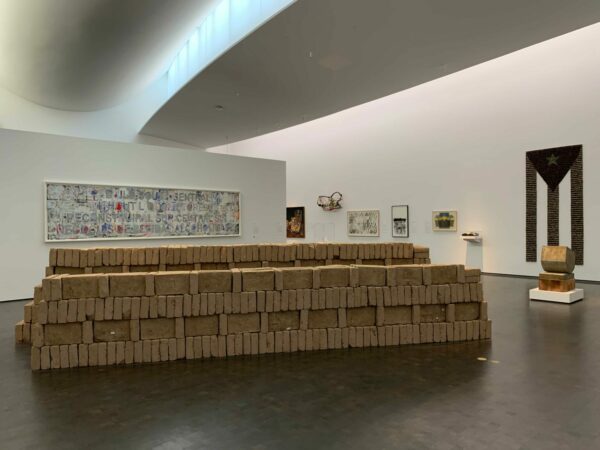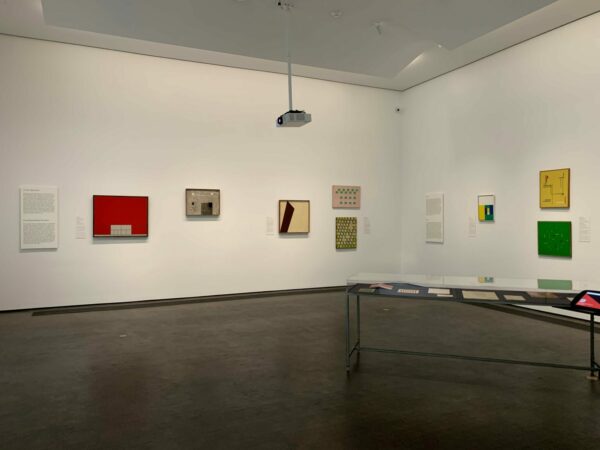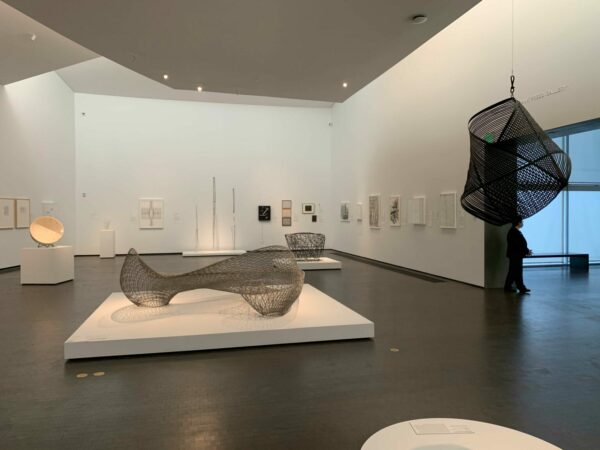Para leer este artículo en español, por favor vaya aquí. To read this article in Spanish, please go here.

Works by Alejandro Cartagena in Border, Mapping, Witness, one of the Kinder Building’s inaugural thematic exhibitions
Mari Carmen Ramírez is the Wortham Curator of Latin American Art at the Museum of Fine Arts, Houston. The MFAH opened its new building for modern and contemporary art, the Kinder Building, this past November, and thanks to Ramírez’s 20-plus-year effort to collect deeply and widely for the museum and create a new type of canon, Latin American and Latino work represent nearly a quarter of all the art on display in building’s inaugural installation. These works create a cross-pollinating dialogue (and reconsidered history and future) with the European and American art on display.
This conversation originally took place in 2019, during the international Latino Art Now! conference, which was in Houston that spring. Ramírez was a keynote speaker.
Roberto Tejada is the Hugh Roy and Lillie Cranz Cullen Distinguished Professor in the Department of English and School of Art at the University of Houston.
Roberto Tejada: I’d like to ask you about a topic central to Latino Art Now! 2019, a theme I imagine you’ll address in your keynote: How to define the difference and interrelation between Latinx and Latin America art? And what are the cultural patterns that mark those differences?
Mari Carmen Ramírez: It’s quite a complex issue because we’re really talking about two “operational constructs,” each one of which involves producers, agents, collectors, and galleries. That is, each entails diverse histories and distinct narratives; to date they have operated as separate domains. The field of Latin American art has a long history in the United States that points back to the Museum of Modern Art in New York (MoMA) and to its founder, Alfred Barr. He was in fact the person who established Latin American art as an “open field.” That category did not even exist in Latin America until recently, nor would anyone have thought of putting together collections from all of Latin America, that is, from countries south of the Rio Grande. I emphasize it as a category that emerged here in the United States, linked from its inception to issues regarding U.S. foreign policy and, increasingly since the late ’70s, to a then-emerging market led by large auction houses (Sotheby’s and Christie’s), and the creation of specialized auctions for this art, both regional and otherwise. This generated a market phenomenon that is now “at its prime,” an unprecedented apex as a market, even as a collecting area, and as a relatively “autonomous” art-historical category. And in point of fact, it has become something of an immediate asset and commodity.
Latinx art, the current term, is an art linked to the civil rights struggles of the 1960s and, on account of its content and political profile, has found it more difficult to be assimilated into the mainstream. Insomuch as it arose connected to regional communities across the continent (to Chicano, Puerto Rican, and Cuban communities, to specific ethnic groups of Latin American origin), it still lacks the infrastructure as sanctioned by the U.S. art world.
RT: It largely remains without an art market.
MCR: It lacks a market: Latinx art is still waiting to be taken up by museum acquisitions and a collector base. It’s an art still in the process of legitimation.
RT: Isn’t this due to an ongoing confusion in the United States about the difference between U.S. artists from Latin America’s diaspora (that is, Latinx) and those originally from Latin America?
MCR: Exactly. This distinction isn’t understood in the United States, so I find myself returning to a basic point: neither Latin American nor Latinx culture is studied in the United States. The average U.S. American citizen, even the most educated, doesn’t comprehend the difference between an Argentinian, a Mexican, a Chicano or a Puerto Rican.
These are vast and immensely complex categories; because in Latin America, as you know, we are talking about 20 countries, three different regions — Central America, South America, and the Caribbean — a thousand ethnicities, culture, and economies gathered together in a “mestizo crucible” that admits all possible combinations.
RT: With very different entry points and pathways to modernity.
MCR: Very different modernities. Latinx communities in the United States are also a very complex phenomenon, with hundreds of ethnicities, and as many cultural experiences and diverse projects. Nevertheless, uniting them is a common history of colonization, largely a common religion, and the community of a shared inherited language. So, these three elements are sufficiently strong as to lead us to examine this phenomenon of Latin Americans and Latinxs as two parts of a great hemispheric phenomenon that is America; as in the Antillean expression, “like two wings from the single bird.”
RT: There are artists and scholars who prefer to categorize Latinx art as a U.S. American art… .
MCR: Indeed, the truth is that these groups were born into U.S American culture and function within it. So, they are right in the sense that this is a facet, yet another factor within the notion of “U.S. American citizenship” or “U.S. American culture,” but no nomenclature can detain the process. It’s yet another migratory flow insofar as the United States has been formed by migrations from all over the world; yet another factor that contributes to making this phenomenon much more complex.

A light work by Carlos Cruz-Diez connects the Kinder Building with the museum’s Caroline Wiess Law Building
RT: And these are legacies that point back as well to the countries of origin, right?
MCR: Yes. The point is that Latinxs, even as they consider themselves U.S. Americans, never cease looking at their cultures of origin, a distinguishing element compared to other immigrations. There’s a strong link on account of that hemispheric and continental history we share in common. At the core of that complexity, it is much more difficult to establish differences; that is, where does one identification end and another begin?
RT: Yes.
MCR: But there’s another factor I intend to point out today in my keynote. In the last 20 years, there has been a great migratory flow from Latin America that includes a vast number of artists, cultural workers and producers who have made the United States their base of operation. Nevertheless, thirty or forty years ago, that phenomenon also existed with artists who, above all, arrived as exiles from various dictatorships. Those artists from Latin America worked as “foreign citizens” within the United States.
RT: As subcultures within U.S. American culture.
MCR: Precisely, although since many of these artists had dual passports, they were able to have exhibitions here in the U.S. while showing as well in Argentina, for example. They could pass simultaneously as Argentinians and U.S. Americans. In fact, they didn’t see themselves as “Latinos” in the United States.
But today there is a tremendous push for so-called “diversity” from the point of view of institutions and government agencies. This has created different conditions and a platform that — with these artists and cultural producers arriving from Latin America to the United States — can be considered part of the Latinx phenomenon. This has given way to frictions with established or “original” Latinx communities; that is, with Chicanos, Puerto Ricans, and many others who have long been struggling for legitimacy.
In demographic terms, this “Latinx community” in fact is no longer the exclusive domain of Chicanos, Puerto Ricans, Cubans, and Dominicans; today all of Latin America is represented in that Latino-North American community. This has led (within communities) to the creation of a sense of pan-ethnicity, a pan-latinidad, especially visible among a generation of youth. In other words, some Latinxs do not necessarily identify themselves as Newyorican, Puerto Rican, Mexican or Chicano. This gives way to a mixture of everything and they consider themselves part of that “Latinx heritage.”
RT: Many of these artists, for example, identify as bi-national or bicultural or multiracial.
MCR: It’s a phenomenon as well at the intersection of ethnicities, genders, and sexualities; hence, Latinx.
RT: Do you believe that U.S. Latinx art will be understood from a Latin American perspective? I think there could be obstacles.
MCR: Optimistically, yes I do believe that within Latin America it will be necessary to understand, insomuch as we are all in the midst of global flows where an unqualified meaning of nationality no longer holds, and no longer functions as it did before, except in situations we see returning to essentialisms.
It seems to me a situation that certainly ought to be understood, especially as recognized from the viewpoint that includes artists from Latin America who take part in this phenomenon and who are redefining its limits. The situation requires a “change of lenses.” That is, instead of viewing the perspective from within, or with regard to Latin America, the point is to account for groups based in a U.S. reality with a view to cultures of origin. Therein lies its richness. And I think we’re already witnessing this in countless exhibitions where emerging curators really have an interest in recuperating that “hemispheric” position from within the United States (a country that originated the cultural construct of “pan-Americanism”).

Marcos Raya, The Anguish of Being and the Nothingness of the Universe, 2000. Installed here in “Between Play and Grief: Selections from the Latino American Collection,” 2019, MFAH, and in the inaugural Kinder Building installation.
RT: To conclude, would you say a few words about the exhibition you curated for the Museum of Fine Arts Houston, Between Play and Grief: Selections from the Latino American Collection [in 2019, for the LAN! conference]. What was the motivating concept behind the exhibition?
MCR: In principle, it showcases the museum’s permanent collection; but in light of this conference, we thought it would be very interesting to present a set of works we acquired almost 10 years ago and that, for lack of permanent gallery space, we had not been able to show until now. It comprises works by Argentinian artists from the ’60s, who were in dialogue with pop art and other international trends.
Jointly we have a series of works by Latinx artists, especially Chicanos and Chicanas, more or less from the same generation, who were also in dialogue with pop art. We thought it was the right time to create a conversation between the works. There are (in the show) extraordinary encounters: on the one hand, Luis Jiménez, an artist who for many years made Houston his home and important base of operations, with his use of fiberglass for monumental sculptures; on the other hand, the work of Juan Carlos Distéfano, from Argentina, who also uses fiberglass for monumental works. These two artists innovated, each in his context, though unaware of the other’s work; they coincided at the same historic moment in questions of form, material, and subject matter. Both artists addressed issues of political censure and social critique. Points of convergence emerge between these two groups (Argentine and Chicano), two “constructs” we need to begin to examine, for there are deep lines of connection that can enrich this whole discussion between the “Latin American” and the “Latinx.”
In the end, these are categories coined by us art historians and academics. The important point is to identify factors that lead us to clarify this particularly rich artistic production, the result of dialogues and exchanges between the artists themselves.






3 comments
I’m a collector, writer and promoter of Latino and Chicano art. It has been my passion for many year. Mari Carmen and Roberto bout have seen my collection and they know my perspective in this regard. I do agree with many of their accretions, I don’t think that representing all Latinos can be encapsulated in one “X”. We are not any minority, we have a solid bace that is standing on the Spanish in America and our ancestors from our homeland. And that!! Makes us unique, not Latin American +.
The is also the indigenous identity, that Latinx is not a diaspora at all, but a reawakening of native identities, tied to this land and it’s nationalities. The label, pan-american can then be seen not from the perspective of nationalities, nation states, but from the experience of roots, rootedness, “raices.”
Mari Carmen Ramírez’s comments are welcome reminders about the complexity of classification nomenclature that attempts to establish unambiguous boundaries among political, cultural or artistic patterns. Perhaps, as Ramierez’s complexity suggests, it is the exceptions, the fuzzy or obscure boundaries or edges of these patterns (all of which have of considerable scope) where disquiet lies.
“Latin America” is a term that does not particularly reference a specific political geography, e.g., “south of the Rio Grande” but refers to those peoples in the Americas who speak a Latin-based or romance language, in most cases either Spanish, Portuguese or French (Rominan and Italian are not as commonly spoken in the western hemsiphere. The “official language” of a nation state tends to be applied as a general condition of the peoples who live in that country. Such generalization has conflicts, for example Spanish may be the official language of Mexico but Zapotec, Nahua, several Maya dialects, and many other languages are the primary spoken language of many indigenous peoples who live in that nation. It seems to be the case that in popular usage, “Latin America” often tends to be regarded as referring to primarily nation states in the western hemisphere where Spanish is the official language. But as a broad term it also includes, for example, French speakers in Canada and Louisiana, among other places. It excludes English, German, Chinese and other non-romance language speakers. And, of course, the term excludes indigenous languages. One dimension of this term that deserves consideration is whether it is being used to categorize nation states that have evolved in this hemisphere or to categorize peoples who live in this hemisphere.